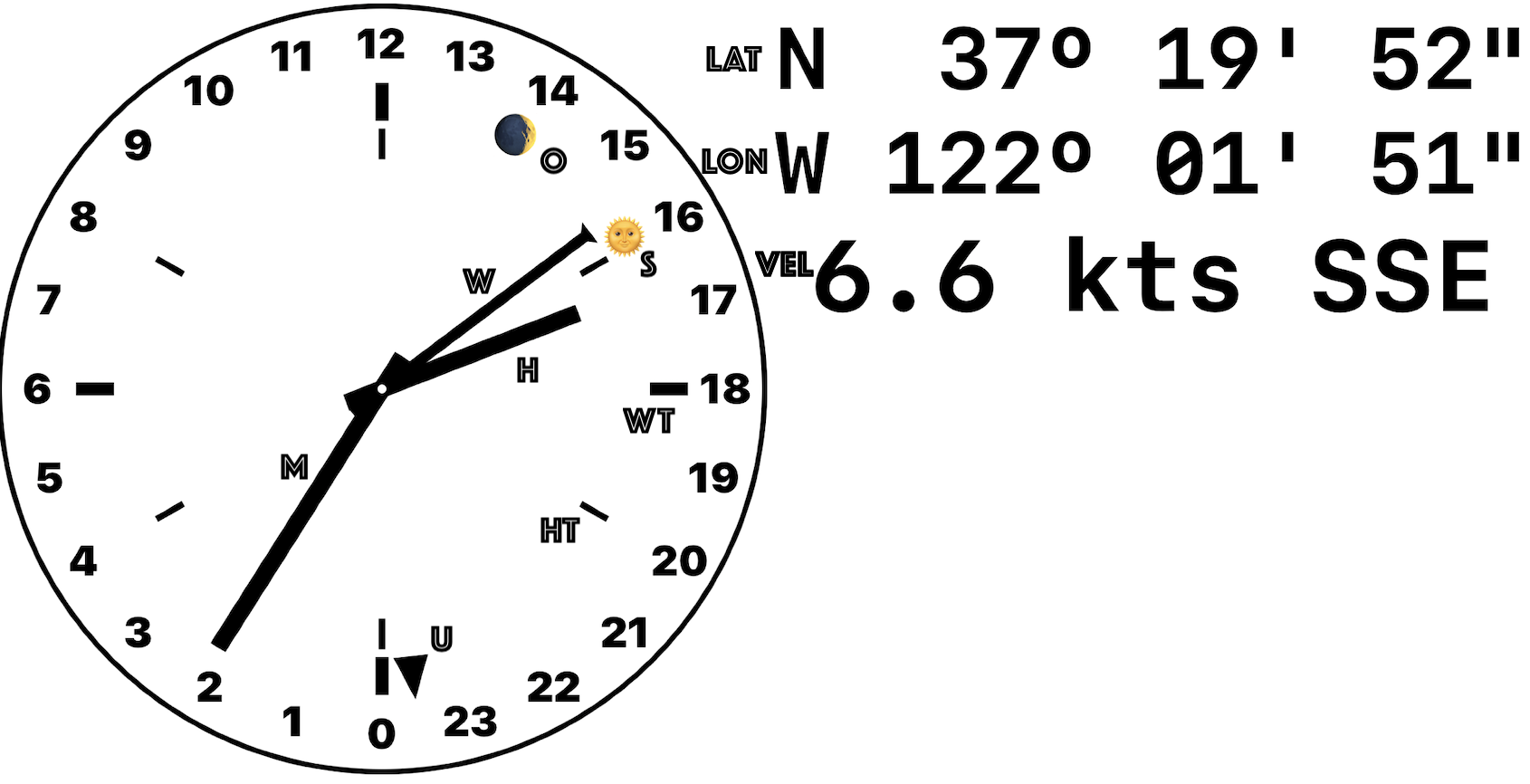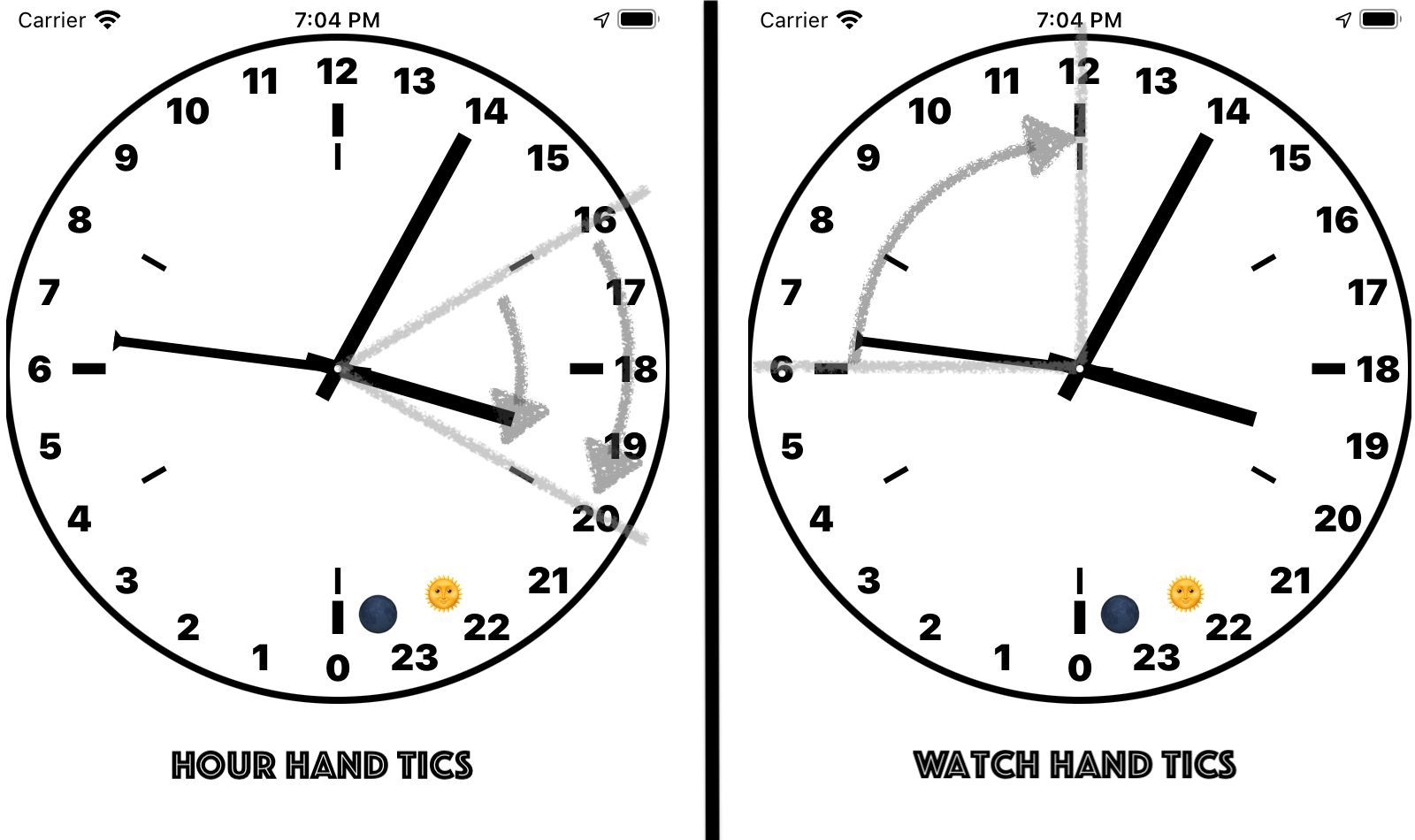Reading the clock
The elements of the clock

The screen capture shows the elements of the clock face annotated with letters. The letters correspond to the following descriptions:
- H: The hour hand. This is the shortest hand. It points to the hour of the day, numbered around the periphery. Zero is midnight. It is shown with the hour hand indicating vertically toward the bottom. Twelve is high noon. It is shown with the hour hand indicating vertically toward the top. The hour hand makes one circuit of the clock face every day. That is every twenty-four hours. The hand in the illustration indicates just after sixteen (16) hours (four in the afternoon).
- M: The minute hand. This is the longest hand. It reads a little differently than a normal clock only because there are twice as many hour labels at the edge. The spacing of the hour labels on a twelve hour clock is five minutes. The spacing of the hour labels on this twenty-four hour clock is half of that– two and one-half minutes. The even numbers do appear at five minute intervals. At 14, we have five minutes after the hour. At 16 we have ten minutes after the hour. At 2 we have thirty five minutes after the hour. The minute hand makes one circuit of the clock face every hour. The hand in the illustration indicates five minutes past the hour.
- W: The watch hand. This is the narrow hand. It shows the current place within a four hour watch. It points up at the beginning of the watch. It points to the right at the end of the first hour of the watch. It points down at the end of the second hour of the watch. It points to the left at the end of the third hour of the watch. The watch hand makes one circuit of the clock face every four hours. The hand in the illustration indicates the beginning of the first hour of the watch.
- S: The sun appears if location is enabled. Knowing the time and your longitude, the app computes the local hour angle of the sun and displays it next to the numbered hour scale. When the sun is at noon, at the top, it is on your local hour meridian, as directly overhead as it will get during the day. Before then it will be moving higher. After then it will be moving lower. It reaches its lowest (out of sight, below you, on the other side of the earth) when the sun is at midnight. See hour angle on Wikipedia for more regarding the hour angle.
- O: The moon appears if location is enabled. Knowing your time and your longitude, the app computes the local hour angle of the moon and displays it next to the numbered hour scale. See the description of S, the local hour angle of the sun, for more detail. U: A triangle indicating the hour UTC (Universal time)
- LAT: Your current latitude (if location is enabled). It reads degrees, minutes, and seconds. It will have an “N” for north latitudes and an “S” for south latitudes.
- LON: Your current longitude (if location is enabled). It reads degrees, minutes, and seconds. It will have a “W” for west latitudes (West of Greenwich). It will have an “E” for east latitudes (East of Greenwich).
- VEL: Your current velocity in tenths of knots and cardinal direction.
- A “knot” is one nautical mile per hour. It is the measure of speed used by ships on the sea. A nautical mile is slightly larger than a statute mile and slightly smaller than two kilometers.
- The clock displays sixteen cardinal directions. They are, moving clockwise around the compass from the north– N, NNE, NE, ENE, E, ESE, SE, SSE, S, SSW, SW, WSW, W, WNW, NW, NNW. Thus the clock shows your direction to the nearest twenty-two and one-half degrees.
- WT: These heavy, outer tics correspond to the watch (W) hand. See a further description in the following.
- HT: These light, inner tics correspond to the hour (H) hand. See a further description in the following.
How the tics deliniate watches

A watch is four hours (in general terms). The watch hand (W) runs around the clock once during the four hours of the watch. It goes a quarter of the way around every hour. These hours show on the clock face with bold tics. On the right hand side of the illustration you see the watch hand in the final hour of the watch. It started this final hour of the watch pointing to the six (6). It will move to point up at the twelve (12) at the end of the watch.
There are six watches in a day (also in general terms). The lighter tics mark the hours where a transition occurs from one watch to the next. The hour hand (H) points to an hour marked by one of these lighter tics at the eight bell changes of the watch. The left of the illustration shows the motion of the hour hand during the four hours of the fifth watch. The watch starts when the hour hand indicates to the tic next to hour sixteen (16). It ends when the hour hand indicates to the tic next to hour twenty (20).
We say “in general terms” above because some watch systems break the fifth watch into two, two-hour, shortened “dog” watches. The clock does not change when such a system is in use. The bells in use are the same. The dog watch splits when the hour indicator points to 18 hours and the watch indicator points down at the zero.